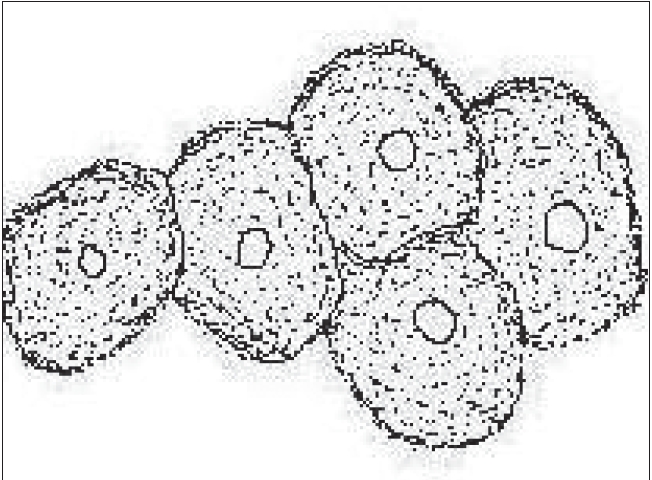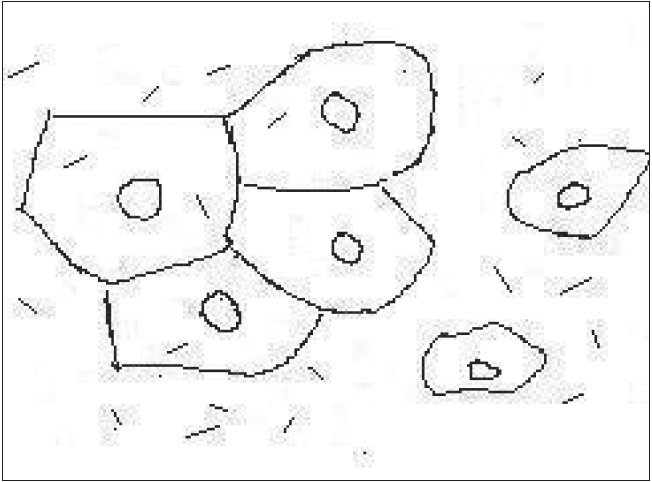Translate this page into:
Clue cell
Correspondence Address:
Silonie Sachdeva
1312, Urban Estate, Phase-1, Jalandhar - 144 022, Punjab
India
| How to cite this article: Sachdeva S. Clue cell. Indian J Dermatol Venereol Leprol 2006;72:392-393 |
 |
| Diagrammatic representation of clue cells coated with coccobacillary organisms with a granular appearance and stippled border |
 |
| Diagrammatic representation of clue cells coated with coccobacillary organisms with a granular appearance and stippled border |
 |
| Diagrammatic representation of normal vaginal squamous epithelial cells with lactobacilli. The cell margins are distinct and lack granularity |
 |
| Diagrammatic representation of normal vaginal squamous epithelial cells with lactobacilli. The cell margins are distinct and lack granularity |
Clue cells are vaginal squamous epithelial cells coated with the anaerobic gram-variable coccobacilli Gardnerella vaginalis and other anaerobic bacteria causing bacterial vaginosis. Clue cells were first described by Gardner and Dukes[1] in 1955 and were so named as these cells give an important "clue" to the diagnosis of bacterial vaginosis. A clue cell can be detected on simple wet mount of vaginal secretions. To be significant for bacterial vaginosis (BV), more than 20% of the epithelial cells on the wet mount should be clue cells.
Pathogenesis
Clue cell phenomenon is attributed to the attachment of adherent strains[2] of G. vaginalis in large numbers to exfoliated epithelial cells of the vagina in presence of an elevated pH. The increase in vaginal pH occurs due to alteration in normal flora characterized by a decrease in lactobacilli and increase in bacteria such as G. vaginalis ,Mycoplasma hominis and anaerobes as Mobiluncus, Bacteroides and Peptostreptococcus species. Lactobacilli help to maintain the acidic pH of healthy vagina and inhibit the growth of anaerobic microorganisms through elaboration of hydrogen peroxide.[3] Factors causing the change in flora are poorly understood. Postulates[4] include the menstrual cycle, concomitant infections, sexual activity, contraceptive methods and antibiotic use. An increase in the local pH favors the growth of bacteria causing BV. The bacteria adhere to the surface of epithelial cells leading to formation of clue cells. Lytic cellular changes are induced by the organisms on clue cells by production of enzymes such as sialidases (neuraminidases) allowing the bacteria to invade and destroy the cells.
Morphology
The clue cells can be demonstrated by microscopic examination of vaginal wet mount preparation. From the speculum, an appropriate amount of vaginal discharge is transferred on the glass slide and a droplet of normal saline is added directly. The preparation is covered with a coverslip and examined under the light microscope at 100x (low power) and 400x (high power) magnifications. The normal vaginal squamous epithelial cells have distinct cell margins and lack granularity [Figure - 1]. Clue cells are seen as squamous epithelial cells with large number of coccobacillary organisms, densely attached in clusters to their surfaces giving them a granular appearance. The cytoplasm appears fuzzy (like shading with black pencil) and the edges of the squamous epithelial cells, which normally have a sharply defined cell border, become indistinct or stippled [Figure - 2]. Polymorpho nuclear leukocytes (PMNs) can also be demonstrated on the normal vaginal wet mount preparation. The vaginal discharge of patients with BV is notable for its lack of PMNs, typically 1 or less than 1 PMN per vaginal epithelial cell.
Clinical significance
Detection of clue cells is the most useful single procedure for the diagnosis of BV. Bacterial vaginosis accounts for 10 to 30% of the cases of infectious vaginitis[5] in women of childbearing age and presents with malodorous vaginal discharge and vulvar irritation. Presence of clue cells (more than 20%) in vaginal discharge is included in Amsel′s[6] criteria for the diagnosis of BV. Other criteria for the diagnosis of BV include: milky, homogeneous, adherent discharge; vaginal pH greater than 4.5; positive whiff test i.e., typical fishy odor on addition of one or two drops of 10% KOH to vaginal discharge and "few or no lactobacilli". The presence of three of the above five is considered diagnostic. The sensitivity and specificity of more than 20% clue cells on wet mount[7] for diagnosis of BV is 81% and 99%. Identification of clue cells can also be done on Papanicolaou smear sampled from the posterior fornix with the sensitivity[8] and specificity of 90% and 97%.
The presence of clue cells in vaginal discharge has also been used to predict postoperative infections[9] after abdominal hysterectomy. Women with positive clue cell detection in air-dried vaginal smears have been found to be at increased risk of postoperative vaginal cuff infections and wound infections.
| 1. |
Gardner HL, Dukes CD. Haemophilus vaginalis vaginitis. A newly defined specific infection previously classified ''Nonspecific'' vaginitis. Am J Obstet Gynecol 1955;69:962-76.
[Google Scholar]
|
| 2. |
Scott TG, Smyth CJ, Keane CT. In vitro adhesiveness and biotype of Gardnerella vaginalis strains in relation to the occurrence of clue cells in vaginal discharges. Genitourin Med 1987;63:47-53.
[Google Scholar]
|
| 3. |
Eschenbach DA, Davick PR, Williams BL, Klebanoff SJ, Young-Smith K, Critchlow CM, et al . Prevalence of hydrogen peroxide-producing Lactobacillus species in normal women and women with bacterial vaginosis. J Clin Microbiol 1989;27:251-6.
[Google Scholar]
|
| 4. |
Saidi SA, Mandal D, Curless E. Bacterial vaginosis in a district genitourinary medicine department: Significance of vaginal microbiology and anaerobes. Int J STD AIDS 1994:5:405-8.
[Google Scholar]
|
| 5. |
Sobel JD. Vaginitis. New Engl J Med 1997;337:1896-903.
[Google Scholar]
|
| 6. |
Amsel R, Totten PA, Spiegel CA, Chen KC, Eschenbach D, Holmes KK. Nonspecific vaginitis. Diagnostic criteria and microbial and epidemiologic associations. Am J Med 1983;74:14-22.
[Google Scholar]
|
| 7. |
Chandeying V, Skov S, Kemapunmanus M, Law M, Geater A, Rowe P. Evaluation of two clinical protocols for the management of women with vaginal discharge in southern Thailand. Sex Transm Infect 1998;74:194-201.
[Google Scholar]
|
| 8. |
Platz-Christensen JJ, Larsson PG, Sundstrom E, Bondeson L. Detection of bacterial vaginosis in Papanicolaou smears. Am J Obstet Gynecol 1989;160:132-3.
[Google Scholar]
|
| 9. |
Larsson PG, Platz-Christensen JJ, Forsum U, Pahlson C. Clue cells in predicting infections after abdominal hysterectomy. Obstet Gynecol 1991;77:450-2.
[Google Scholar]
|
Fulltext Views
48,109
PDF downloads
5,862





